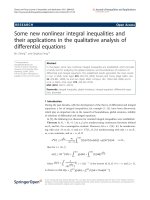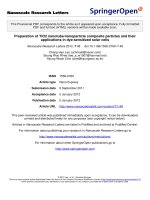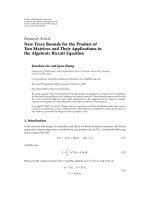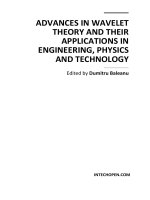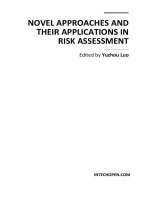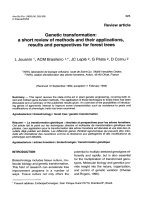Stochastics global optimization methods and their applications in chemical engineering
Bạn đang xem bản rút gọn của tài liệu. Xem và tải ngay bản đầy đủ của tài liệu tại đây (3.84 MB, 266 trang )
STOCHASTIC GLOBAL OPTIMIZATION METHODS
AND THEIR APPLICATIONS IN CHEMICAL
ENGINEERING
MEKAPATI SRINIVAS
NATIONAL UNIVERSITY OF SINGAPORE
2007
STOCHASTIC GLOBAL OPTIMIZATION METHODS AND THEIR
APPLICATIONS IN CHEMICAL ENGINEERING
MEKAPATI SRINIVAS
(B.Tech., National Institute of Technology, Warangal, India)
A THESIS SUBMITTED
FOR THE DEGREE OF DOCTOR OF PHILOSOPHY
DEPARTMENT OF CHEMICAL AND BIOMOLECULAR ENGINEERING
NATIONAL UNIVERSITY OF SINGAPORE
2007
To My Parents
&
Late Sri Ch. Deekshitulu
ACKNOWLEDGEMENTS
I would like to express my sincere gratitude to my supervisor Prof. G. P.
Rangaiah for his invaluable guidance, continuous support and encouragement throughout
this work, particularly at difficult times. I would also thank him for teaching me the
important things: positive attitude, critical thinking and analysis while attacking any
problem during my research work.
I would like to thank Prof. I. A. Karimi, Prof. A. K. Ray, Prof. M. S. Chiu, Prof.
X. S. Zhao and Prof. T. C. Tan for teaching me the fundamentals and advanced topics in
chemical engineering. I would also like to thank Prof. Raj Rajagopalan, Prof. S.
Lakshminarayanan, Prof. P. R. Krishnaswamy and other professors in the chemical and
biomolecular engineering department who have contributed directly or indirectly to this
thesis. I would like to thank technical and non-technical staff in the department for their
assistance on several laboratory related issues.
Many thanks to my friends Sudhakar, Murthy, Sathish, Velu, Prakash, Yelneedi,
Satyanarayana, Umapathi and B.V. Srinivas for their continuous support and
encouragement over the years. Special thanks to my colleagues and other friends in the
department who made my life at NUS more enjoyable.
I would like to express my endless gratitude to my beloved parents and family
members for their everlasting love, support and encouragement in my life particularly in
i
pursing graduate studies. I would like to extend my gratitude to my master Sri Ch.
Satyanarayana and his son Late Ramalinga Deekshitulu for their guidance and help in
achieving my goals.
I sincerely acknowledge the National University of Singapore for providing me
the opportunity and financial support to pursue doctoral studies.
ii
TABLE OF CONTENTS
Acknowledgements i
Table of Contents iii
Summary vii
Nomenclature x
List of Figures xvii
List of Tables xix
Chapter 1 Introduction 1
1.1 Importance of Global Optimization 1
1.2 Classification of Global Optimization Methods 4
1.3 Motivation and Scope of the Work 23
1.4 Outline of the Thesis 28
Chapter 2 Implementation and Evaluation of
Random Tunneling Algorithm 29
2.1 Introduction 30
2.2 Implementation of Tunneling 38
2.3 Description of the Algorithm 43
2.4 Benchmark Problems 45
2.5 Phase Equilibrium Problems 48
2.6 Parameter Estimation Problems 55
2.7 Results and Discussion 58
iii
2.7.1 Parameter Tuning 58
2.7.2 Performance of RTA for Benchmark Problems 61
2.7.3 Performance of RTA for Phase Equilibrium Calculations 64
2.7.4 N-dimensional Test Function 70
2.7.5 Performance of RTA for Parameter Estimation Problems 75
2.8 Summary 77
Chapter 3 Evaluation of Differential Evolution and Tabu Search 79
3.1 Introduction 80
3.1.1 Differential Evolution 83
3.1.2 Tabu Search 86
3.2 Implementation of DE and TS 89
3.3 Benchmark Problems 90
3.3.1 Parameter Tuning 91
3.3.2 Results and Discussion 93
3.4 Phase Equilibrium Problems 96
3.4.1 Parameter Tuning 97
3.4.2 Results and Discussion 97
3.5 Phase Stability Problems 101
3.5.1 Parameter Tuning 103
3.5.2 Results and Discussion 106
3.6 Summary 112
iv
Chapter 4 Differential Evolution with Tabu List for
Global Optimization 113
4.1 Introduction 114
4.2 Differential Evolution with Tabu List 117
4.2.1 Description of the method 120
4.3 Benchmark Problems 123
4.4 Phase Equilibrium Calculations 125
4.5 Parameter Estimation Problems 127
4.6 Implementation and Evaluation of DETL 128
4.7 Parameter Tuning 130
4.8 Results and Discussion 132
4.8.1 Benchmark Problems 132
4.8.2 Phase Equilibrium Calculations 141
4.8.3 Parameter Estimation Problems 144
4.9 Summary 146
Chapter 5 Differential Evolution with Tabu List for
Solving NLPs and MINLPs 147
5.1 Introduction 148
5.2 Description of DETL 152
5.3 Handling Integer and Binary Variables 155
5.4 Handling Constraint and Boundary Violations 156
5.5 Implementation and Evaluation 157
5.6 Non-linear Programming Problems (NLPs) 158
v
5.6.1 Parameter Tuning 160
5.6.2 Results and Discussion 162
5.7 Mixed-Integer Non-linear Programming Problems (MINLPs) 166
5.7.1 Parameter Tuning 166
5.7.2 Results and Discussion 167
5.8 Summary 172
Chapter 6 A New Transformation for
Stochastic Global Optimization Methods 173
6.1 Introduction 174
6.2 Proposed Transformation 176
6.3 Implementation and Evaluation 180
6.4 A Benchmark Problem Similar to Phase Equilibrium Calculations 181
6.5 Application to Benchmark Problems 183
6.5.1 Results and Discussion 184
6.6 Summary 189
Chapter 7 Conclusions and Recommendations 190
7.1 Conclusions 190
7.2 Recommendations for Future Works 192
References 197
Appendix A An Integrated Stochastic Method for
Global Optimization of Continuous Functions 222
Appendix A Mathematical Formulation of NLPs and MINLPs
in Chapter 5 227
vi
SUMMARY
Stochastic global optimization is an active research area due to its ability to
provide the best possible solutions to the highly non-linear, non-convex and
discontinuous objective functions. The broad objective of this study is to develop, apply
and evaluate reliable and efficient stochastic global optimization methods for chemical
engineering applications. Two benchmark problems similar to phase equilibrium
calculations have also been proposed and studied in this thesis.
After reviewing the literature, a method, namely, random tunneling algorithm
(RTA) is selected, implemented and evaluated for benchmark problems involving 2 to 20
variables and a few to hundreds of local minima. Its potential is then tested for chemical
engineering applications, namely, phase equilibrium calculations via Gibbs free energy
minimization and parameter estimation in models. Phase equilibrium problems
considered include vapor-liquid, liquid-liquid and vapor-liquid-liquid examples involving
several components and popular thermodynamic models, and parameter estimation
problems consist of up to 34 variables. RTA successfully located global minimum for
most the examples but its reliability is found to be low for problems with a local
minimum comparable to the global minimum.
Subsequently, two methods, namely, differential evolution (DE) and tabu search
(TS) have been evaluated for benchmark problems, phase equilibrium calculations and
phase stability problems. The results show that DE is more reliable in locating the global
vii
minimum compared to TS whereas the latter is computationally more efficient than the
former for the examples tested.
Guided by the insight obtained from DE and TS, a new method, namely,
differential evolution with tabu list (DETL) is proposed by integrating the strong features
of DE and TS. DETL is initially tested over many of benchmark problems involving
multiple minima. The results show that the performance of DETL is better compared to
DE, TS and the recent modified differential evolution (MDE). DETL is then evaluated
for challenging phase equilibrium calculations and parameter estimation problems in
differential and algebraic systems. It is also evaluated for many non-linear programming
problems (NLPs) having constraints and different degrees of complexity, and several
mixed-integer non-linear programming problems (MINLPs) which involve process
design and synthesis problems. Overall, the performance of DETL is found to be better
than that of DE, TS and MDE.
Finally, a transformation for the objective function is proposed to enhance the
reliability of stochastic global optimization methods. The proposed transformation is
implemented with DE, and is evaluated for several test functions involving multiple
minima. Although the proposed transformation is found to be better than a recent
transformation in the literature, further investigation is required to improve its
effectiveness for problems with more variables.
viii
Comprehensive evaluation of the selected stochastic optimization methods, and
the new method, benchmark problems and transformation proposed in this study are of
interest and use to the global optimization community.
ix
NOMENCLATURE
Abbreviation Explanation
DE : Differential Evolution
DETL : Differential Evolution with Tabu List
ECTS : Enhanced Continuous Tabu Search
ES : Evolutionary Strategies/Easom function
FAEA : Fast Annealing Evolutionary Algorithm
FB : Forcing to Bounds
GA : Genetic Algorithms
GM : Global Minimum
GP : Goldstein and Price function
GRDT : Gradient Descent with Dynamic Tunneling
GW : Griewank function
H : Hartmann function
HDE : Hybrid Differential Evolution
IDE : Improved Differential Evolution
LLE : Liquid-Liquid Equilibrium
LM : Local Minimum
mHB : modified Himmelblau Function
mNDT : modified N-dimensional Test Function
mROS : modified Rosenbrock Function
MBB : Modified Bouncing Ball
x
MDE : Modified Differential Evolution
MINLPs : Mixed-Integer Non-Linear Programming problems
MTT : Monotonic Transformation
NFE : Number of Function Evaluations
NFG : Number of Function and Gradient evaluations
NLPs : Non-Linear Programming problems
NM : Nelder-Mead
NRTL : Non-Random Two Liquid
OA/ER : Outer approximation/Equality Relaxation
PEC : Phase Equilibrium Calculations
PS : Phase Stability
PSO : Particle Swarm Optimization
QN : quasi-Newton
RA : Rastrigin function
RG : Random Generation
ROS : Rosenbrock function
RT : Random Tunneling
RTA : Random Tunneling Algorithm
SA : Simulated Annealing
SC1 : Stopping Criterion 1
SC2 : Stopping Criterion 2
SF : Snyman-Fatti
SH : Shubert function
xi
SPT : Stochastic Pijavaskij Tunneling
SR : Success Rate
SSE : Sum of Squared Errors
TPDF : Tangent Plane Distance Function
TRUST : Terminal Repeller and Unconstrained Subenergy Tunneling
TS : Tabu Search
UNIQUAC : Universal Quasi-Chemical
VLE : Vapor-Liquid Equilibrium
VLLE : Vapor-Liquid-Liquid Equilibrium
WOT : Without Transformation
WT : With Transformation
ZAK : Zakharov function
Symbol Explanation
A Amplification factor
c Parameter of the proposed transformation
CR Crossover constant
E (x, x
*
) Virtual objective function
E
rep
(x, x
*
) Repeller term
E
sub
(x, x
*
) Subenergy tunneling function
f
Objective function
f
trans
Transformed objective function
F Estimated objective function using Lipschitz constant, or Total
moles of feed
xii
g Inequality constraint
G Gibbs free energy
Gen
max
Maximum number of generations
G
Partial molar Gibbs free energy
RT
G
Dimensionless Gibbs free energy
h Equality constraint
h
n
Length of the n
th
hyper-rectangle
H Homotopy function, or Dimensionless tangent plane distance
Function, or Heavyside function
Iter Iterations
Iter
max
Maximum number of iterations
k Rate constant
L
Lipschitz constant
m
1
Number of equality constraints
m
2
Number of inequality constraints
n Number of moles
n
k
Total number of moles in phase k
n
i
k
Number of moles of component i in phase k
nc Number of components
N Number of real/continuous variables of the given problem
N
neigh
Number of neighbors in each iteration
N
p
Number of promising points
N
t
Number of taboo points
xiii
NP Population size
NP
init
Initial population size
p Total number of continuous, binary and integer variables
ps Number of perturbations in a particular tunneling phase
P System pressure
R Universal gas constant
s Centroid of the hyper-rectangle
ss Step size
S Sign variable for the direction of tunneling
Sc Successive iterations/generations
Sc
max
Maximum number of successive generations without
improvement in the best function value
t Homotopy parameter, or Tangent plane
tls Tabu list size
tp Maximum number of tunneling phases
tr Tabu radius
T Temperature
T
~
m – dimensional temperature vector
U Under-estimator or Trial vector/individual
V Mutated vector/individual
x Decision variable, or Mole fraction in liquid phase
xandx
&&&
System of first and second order differential equations
1
x
~
m - dimensional composition vector of component 1
i
x
&
i
th
component of the dynamic system
xiv
l
i
x and Lower and upper bounds of i
u
i
x
th
element of x
i,1
x
Measured x
1
in i
th
experiment
X Target vector/individual
y Binary variable, or Mole fraction in vapor phase
z
i
Moles of i
th
component in the feed
Greek Letters Explanation
α Constant
i
β
i
th
component of the decision variable
i
γ
Activity coefficient of component i
θ Energy interaction parameter vector, or Decision variable in
parameter estimation problems
λ Magnitude of perturbation
i
φ
Fugacity coefficient of component i
σ Standard deviation
ε Radius
Superscripts Explanation
k Phase index
l Lower bound
L Liquid phase
u Upper bound
V Vapor phase
xv
Subscripts Explanation
G/J/gen Generation number
init Initial stage
max Maximum number
neigh Neighbor point
P Promising point
t Tabu point
xvi
LIST OF FIGURES
1.1 Schematic of the non-linear function, f (x), with multiple minima 3
1.2 Classification of global optimization methods 5
1.3 Branch and bound tree 7
1.4 Saw-tooth cover in Lipschitz optimization 10
2.1 Schematic diagram of TRUST showing the original function, f(x),
subenergy transformation, E
sub
(x, x
*
) in equation 2.1 and virtual
objective function, E (x, x
*
) in equation 2.3
36
2.2 (a) Contour diagram and (b) Schematic of tunneling for modified
Himmelblau function
42
2.3 Flowchart of RTA implemented in this study
44
2.4 Original and modified N-dimensional test functions in one
dimensional case
72
2.5 Contour plots of (a) Original and (b) Modified test functions in
two dimensional case
73
3.1 Flow chart of DE-QN
84
3.2 Schematic diagram of crossover operation; for continuous lines,
ran ≤ CR, and for dotted lines, ran > CR
86
3.3 Flow chart of TS-QN
88
3.4 Generation of neighbors for example 2 (composition 5) using
hyper- rectangles (points with ‘o’) and randomly (points with ‘*’)
from the best point (point with ‘+’) at β = {0.69280; 0.01298}
106
4.1 Contour diagram of modified Himmelblau (mHB) function; ‘
{’
and ‘Â’ denotes the points generated by DE and DETL
respectively. GM is the global minimum whereas LM1, LM2 and
LM3 are the local minima. 119
4.2 Flowchart of DETL
121
xvii
4.3 Convergence profiles for solving (a) modified Himmelblau, (b)
Goldstein and Price, and (c) Rastrigin functions, by TS, DE, MDE
and DETL.
140
&
141
5.1 Flowchart of DETL 153
6.1 (a) modified Himmelblau function (b) Effect of 1
st
part of
equation 6.1 for mHB function and (c) Effect of the proposed
transformation (equation 6.1) for mHB function
178
&
179
xviii
LIST OF TABLES
2.1 Comparison of computational efficiency of different global
optimization methods
34
2.2 Global minimum for benchmark problems 48
2.3 Selected examples for (a) vapor-liquid, (b) liquid-liquid and
(c) vapor-liquid-liquid equilibrium
53 & 54
2.4 Global and local minima for VLE parameter estimation
problem with 18 variables
57
2.5 Average NFE for (a) benchmark problems (<10 variables) and
(b) benchmark problems (>10 variables)
62
2.6 (a) Average NFE for VLE and LLE examples and (b) Average
NFE and SR: VLLE examples
66 & 69
2.7 Minima for the modified N-dimensional test function (4
variables)
71
2.8 Average NFE and success rate of RTA (with general stopping
criterion): modified N-dimensional test function
74
2.9 Average NFE and CPU time for parameter estimation
problems
76
3.1 Details of the benchmark problems 90
3.2 Optimal parameter values for TS-QN and DE-QN
92
3.3 (a) Success rate (SR) and Number of Function Evaluations
(NFE) for solving benchmark problems by DE-QN and TS-
QN and (b) SR and NFE using DE-QN and TS-QN with same
N
neigh
/NP (= 20) and Iter
max
/Gen
max
(=50N)
94
3.4 (a) SR and NFE for solving phase equilibrium problems by
DE-QN and TS-QN and (b) Comparison of CPU times for
DE-QN and TS-QN with those in the literature
99
3.5 Details of the phase stability example 5 – toluene (1), water
(2) and aniline (3) at 298 K and 1.0 atm (Castillo and
Grossman, 1981) 103
xix
3.6 Global and comparable minima for PS problems
105
3.7 SR and NFE for solving phase stability problems by DE-QN,
TS-S-QN, TS-M-QN and TS-R-QN using SC1
107
3.8 Comparison of SR and NFE for solving phase stability
problems by DE-QN and TS-M-QN using SC1 and SC2
109
3.9 Comparison of performance of TS-QN with different types
of neighbor generation for (a) benchmark problems and
(b) phase equilibrium calculations
111
4.1 Benchmark Problems
124
4.2 Parameter Estimation Problems 128
4.3 Optimal Values of Parameters in TS, DE, MDE and DETL 131
4.4 Results for Benchmark Problems - Moderate Functions 133
4.5 % Reduction in NFE of DETL for Benchmark Problems –
Moderate Functions
136
4.6 Results for Benchmark Problems – Difficult Functions
137
4.7 % Reduction in NFE of DETL for Benchmark Problems –
Difficult Functions
138
4.8 Results for Phase Equilibrium Calculations 143
4.9 % Reduction in NFE of DETL for Phase Equilibrium
Calculations
143
4.10 Results for Parameter Estimation Problems 144
4.11 % Reduction in NFE of DETL for Parameter Estimation
Problems
145
5.1 Characteristics of the NLP and MINLP problems studied 159
5.2 Optimal values of parameters in DE, MDE and DETL 161
5.3 SR and NFE of DE, MDE and DETL for NLPs 163
xx
5.4 Percentage reduction in NFE for NLPs 165
5.5 SR and NFE of DE, MDE and DETL using RG, FB and
Mixed approaches for MINLPs
168
5.6 Percentage reduction in NFE for MINLPs 171
6.1 Trend of comparable minima with α for the modified
Rosenbrock function (5 variables case)
183
6.2 Function values at the comparable minimum for the modified
Rosenbrock function with α = 1.50×10
-3
183
6.3 Effect of the parameter, c, on the performance of DE 184
6.4 Effect of re-initialization on (a) SR of DE and (b) NFE for DE 185
& 186
6.5 SR and NFE of DE with and without transformations 188
xxi
Chapter 1 Introduction
CHAPTER 1
INTRODUCTION
1.1 Importance of Global Optimization
Many practical engineering problems can be posed as optimization problems
for which a global optimal solution is desired. Global optimization methods are
important in many applications because even slightly better solutions can translate
into large savings in time, money and/or resources. In several modeling applications,
they are required for correct prediction of process behavior. Literature abounds a
range of applications of global optimization from estimating the amount of
chlorophyll concentration in vegetation (Yatsenko et al., 2003) to the design of Earth-
Mars transfer trajectories (Vasile et al., 2005). Global optimization techniques are
typically general and can be applied to complex problems in engineering design
(Grossmann, 1996), business management (Arsham, 2004), bio-processes (Banga et
al., 2003), computational biology (Klepeis and Floudas, 2003), computational
chemistry (Floudas and Pardalos, 2000), structural optimization (Muhanna and
Mullen, 2001), computer science (Sexton et al., 1998), operations research (Faina,
2000), exploratory seismology (Barhen et al., 1997), process control and system
design (Floudas, 2000a) etc.
The aim of global optimization is to find the solution in the region of interest,
for which the objective function achieves its best value, the global optimum. Global
minimization aims at determining not just a local minimum but the minimum among
the minima (smallest local minimum) in the region of interest. In contrast to local
1




